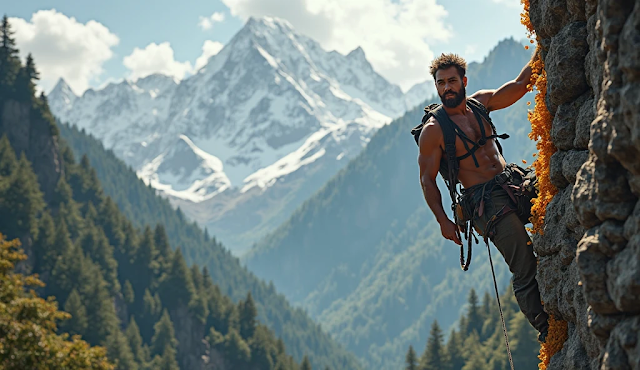Discover how Jean-Marc Boivin made history in 1988 with the first paraglide descent from Everest. Explore his daring feat and lasting legacy in mountaineering.
Jean-Marc Boivin: First Paraglide Descent from Everest (1988)
Mount Everest—the world’s highest peak—has been a stage for audacious human achievements. Among its most daring chapters is Jean-Marc Boivin’s 1988 paraglide descent from the summit. A French extreme sports pioneer, Boivin didn’t just climb Everest; he flew off it, redefining adventure sports forever. His groundbreaking feat blended mountaineering grit with aerial innovation, cementing his legacy as a trailblazer.
Early Life: The Making of an Adventure Icon
A Born Risk-Taker
Jean-Marc Boivin (1948–1990) grew up in France’s Alps, where he honed his passion for climbing, skiing, and paragliding. By his 20s, he was already a celebrated alpinist, known for tackling uncharted routes.
Pre-1988 Milestones:
1979: Speed-climbed Peru’s Huascarán Norte in 3 hours.
1985: Skied down Mount Kilimanjaro.
1987: Paraglided from Argentina’s Aconcagua summit.
The Paragliding Visionary
Boivin saw paragliding as more than a sport—it was a tool to revolutionize mountain descents. His mantra:
“Why climb down when you can fly?”
The 1988 Everest Expedition: A Dual Challenge
Climbing to the Summit
Boivin joined a French-led Everest expedition in 1988. His goal was twofold:
Summit via the Southeast Ridge.
Paraglide from the top back to Base Camp.
Key Expedition Details:
Team: 15 climbers and support staff.
Route: Traditional Southeast Ridge (used by Hillary/Norgay).
Summit Date: September 26, 1988.
Preparing for the Flight
Boivin’s paragliding gear was minimalist by today’s standards:
Glider: A 28m² paraglider (no lightweight modern materials).
Harness: Basic straps with minimal padding.
Oxygen: A single cylinder for the flight.
The Historic Paraglide: Soaring into History
Launching from the Summit
At 8:45 AM on September 26, Boivin stood atop Everest. After planting the French flag, he unpacked his glider in -30°C winds. With no room for error, he sprinted 15 meters downhill and leapt into the void.
The 12-Minute Flight
Altitude Drop: 3,000 meters (29,032 ft to 21,000 ft).
Speed: Averaged 45 km/h.
Landing Site: South Col (near Camp IV).
Boivin later recalled:
“The silence was surreal—just the wind and my heartbeat. I felt like a bird escaping the mountain’s grip.”
Risks & Challenges: Defying Death Zone Odds
Environmental Threats
Hypoxia: Flying at 29,000 ft with oxygen levels < 30% of sea level.
Wind Gusts: Sudden updrafts threatened to collapse the glider.
Extreme Cold: Risk of frostbite and gear malfunction.
Technical Limitations
1980s Gear: Bulky glider, no GPS, and limited thermal protection.
Launch Zone: A 5m² platform on Everest’s summit ridge.
Criticism & Controversy
Some purists called the stunt “reckless,” arguing it trivialized Everest’s dangers. Boivin countered:
“Innovation requires risk. This wasn’t a stunt—it was a new language of exploration.”
Legacy: How Boivin Changed Adventure Sports
Pioneering High-Altitude Paragliding
Boivin’s descent inspired a new genre of extreme sports:
Speedflying: Hybrid of paragliding and ski mountaineering.
Adventure Racing: Multi-disciplinary endurance challenges.
Records Influenced by Boivin:
2001: Bertrand Roche paraglides from Everest.
2011: Ueli Steck’s “Skyrunner” Everest ascent.
2020: Horacio Llorens wingsuit flights in the Himalayas.
Technological Advancements
His feat drove innovations in:
Lightweight Gliders: Carbon fiber frames and ripstop nylon.
High-Altitude Gear: Insulated suits and portable oxygen systems.
Tragic End & Lasting Impact
Boivin died in 1990 during a waterfall rappelling accident in Venezuela. Yet, his Everest flight remains a symbol of audacity, inspiring documentaries like Wings Over Everest and athletes like Kilian Jornet.
Conclusion: The Eternal Daredevil of Everest
Jean-Marc Boivin’s 1988 paraglide descent was more than a record—it was a manifesto for reimagining human potential. By merging mountaineering with flight, he proved that even the world’s tallest peak could be a launchpad for innovation and freedom. Today, his spirit lives on in every adventurer who looks skyward and asks, “What if?”
Extreme sports pioneer, high-altitude paragliding, Everest paraglide record, adventure sports innovation, death zone risks, paragliding technology.








0 Comments